Southern California Contest Club
Stew Perry Topband: December 27-28 ARRL RTTY Roundup: January 3-4 NAQP CW: January 10-11
Stew Perry Topband: December 27-28 ARRL RTTY Roundup: January 3-4 NAQP CW: January 10-11
Past Feature Stories (Newest to Oldest)
S56X Single Op Contest Station - Dušan Gomboc S56X
May 2014
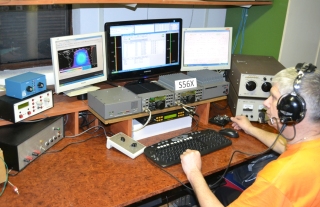 S56X is a single OP location, located in the NE part of Slovenia near the Austrian border, in a small village named Gerlinci. The location occupies approximately
5 acres and is in close proximity of my family home. No industrial plants are present in the neighborhood, so the location is relatively quiet.
S56X is a single OP location, located in the NE part of Slovenia near the Austrian border, in a small village named Gerlinci. The location occupies approximately
5 acres and is in close proximity of my family home. No industrial plants are present in the neighborhood, so the location is relatively quiet.My first amateur radio license (call sign YU3OI) dates from the time of former Yugoslavia. After the Slovenian declaration of independence I started with a homemade 4 EL 3 band Cubical Quad antenna, operating at the upper three shortwave bands, with a former call sign S51OI.
A short time after, a Wilkinson driven 80m 4 Square array, mounted on 4 grounded lattice towers was erected. Better results were achieved on upper bands, mainly because the site is located in a moderate depression. more
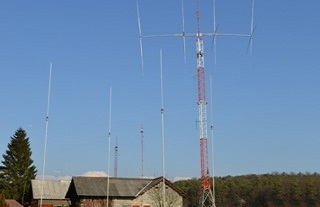 In 2001 a new 40m high free-standing tower was erected to enable the installation of low band horizontally polarized antennas. Encouraged with the former
20 m Cubical Quad's performance, a 40 m Dual Driven Dual Mode Diamond Quad project was started immediately after.
In 2001 a new 40m high free-standing tower was erected to enable the installation of low band horizontally polarized antennas. Encouraged with the former
20 m Cubical Quad's performance, a 40 m Dual Driven Dual Mode Diamond Quad project was started immediately after.The first photo of this antenna, which is still in use, is dated on May 18th, 2001. In the beginning only an Out of Phase Mode was supported whilst a second mode, the so called "Near In Phase Mode" was added later to adapt the antenna to rapidly changing propagation conditions.
Although the second mode resulted in considerable operational benefits, an additional system of two orthogonally spaced and phase driven dipoles for the 40m band was later added specifically for high take-off angles.
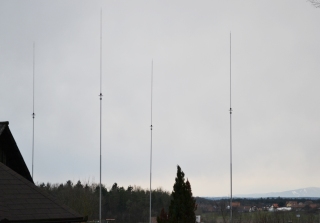 In 2005, I changed my call sign to S56X. During this time it became apparent, that the old 80m 4 Square ground system had started falling apart. A new 4 Square
ground system, arranged for dual band use (80 and 40m, to save space and money) was built in it's place and a new dual band free-standing 4 Square antenna array
was added, initially for the 40m band (λ/4 spacing). A switch-box function was later implemented to adapt 4 Square array operation for the 80m band
(λ/8 spacing) as well.
In 2005, I changed my call sign to S56X. During this time it became apparent, that the old 80m 4 Square ground system had started falling apart. A new 4 Square
ground system, arranged for dual band use (80 and 40m, to save space and money) was built in it's place and a new dual band free-standing 4 Square antenna array
was added, initially for the 40m band (λ/4 spacing). A switch-box function was later implemented to adapt 4 Square array operation for the 80m band
(λ/8 spacing) as well.Recently, a 40m horizontal loop has been installed on the lift tower.
In the early beginnings, a second-hand shortwave transceiver FT101E and a homemade KO-1.5 linear amplifier (S51ZX design) were used for transmission. In 2001 an Elecraft K2 QRP kit was ordered, assembled and upgraded with a 180W PA module with the assistance of S51ZX.
 This K2 has endured it's first long-term test (my 2002 Mauritius holiday trip - 3B8/S51OI) without issues. A few modifications and improvements were made during
it's last operational decade, but this small transceiver has fulfilled nearly all of my expectations.
This K2 has endured it's first long-term test (my 2002 Mauritius holiday trip - 3B8/S51OI) without issues. A few modifications and improvements were made during
it's last operational decade, but this small transceiver has fulfilled nearly all of my expectations.In 2012 an assembled and virtually unused second-hand K2 with an autotuner was purchased from OM Mike Lee (AA6ML – former WB6RTH - Florida).
This station was rearranged, it's minor faults rectified and successfully put into operation as a second contest transceiver. Both K2 stations are connected to a modified EZ Master controller and running on Writelog contest software.
My activity is focused mainly on low frequency (80 and 40m) HF bands. As much as time permits, I participate in allmost all CQWW, CQWPX and ARRL contests, where good EU and World rankings have been achieved in the HF category.
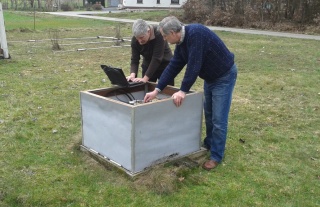 Some of these results, specially these listed below, are considered as my personal success:
Some of these results, specially these listed below, are considered as my personal success:WORLD - 1st PLACE HP SSB S/OP/A- 40m 2006 - CQWPX
WORLD - 1st PLACE HP CW S/OP/A-40m 2008 - CQWPX
WORLD - 1st PLACE HP CW S/OP/A-80m 2009 – CQWPX
EUROPE - 1st PLACE HP SSB S/OP/A- 40m 2012 – CQWPX
EUROPE - 1st, WORLD- 2nd PLACE HP SSB S/OP/A - 40m 2012 - CQWW
Many thanks also to my friend S51ZX, whose innovative ideas helped my antenna systems to be competitive with those of the global elite.
73 Dušan Gomboc S56X More pictures: 1 2 close
HD2A: The Sapo Loco Station - Alberto Pincay HC2AQ
May 2014
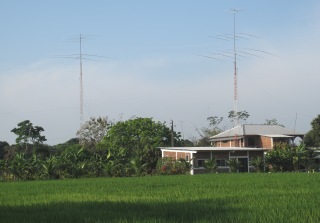 Rescuing old history and referring to its entangled past, it is not that far away that we produce the sensation of reliving it again. That is what I feel when I refer
to the “HD2A dream”.
Rescuing old history and referring to its entangled past, it is not that far away that we produce the sensation of reliving it again. That is what I feel when I refer
to the “HD2A dream”.I cannot fail to mention Roberto-HC2GT and his enthusiastic activities to stimulate HC2 amateur radio operators. Today, because of personal health issues, Roberto is mainly dedicated to fighting for his own survival. The following is a brief tribute to his efforts in supporting our activities.
When was HD2A born? Was it born with some general radio activity on an Ecuadorean beach 20 years ago or in some contest somewhere on the beach? It’s not important now. The true inspiration and the spirit of competition without a doubt came from Alfredo-HC2 Sapo Loco (Crazy Frog), a global winner of many CW competitions over the years. more
 On the eve of one of those past events I received a telephone call from Robert-HC2GT, asking if my Kenwood TS-940 and TL-922 and home antennas were available for
a contest operation.
On the eve of one of those past events I received a telephone call from Robert-HC2GT, asking if my Kenwood TS-940 and TL-922 and home antennas were available for
a contest operation.I was happy to oblige and meet his needs. We operated, not very seriously, from the library of my home in the multi-single category and all of the equipment worked perfectly, just like Swiss watches.
Shortly thereafter, my ranch which is 20 miles North from Guayaquil named “La Guadalupe” was remodeled and we moved to that location. In the presence of lots of beer, BBQ’s, humid heat and mosquito’s we hoisted up dipoles for 10, 15, 20 and 40 meters. We made plenty of QSO’s that evening. Vatican on 15m, WOW!!! We even ran the HC NET “Cadena HC” that evening on 7.060 mHz LSB from 0000-0100z. The HC NET “Cadena HC” has been running continuously every day for over 32 years. That evening the seed was planted for a more permanent contest station.
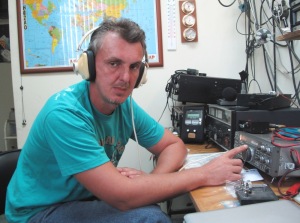 Air conditioning was installed in the shack and new power outlets were installed for both 110vac and 220vac, ground rods, etc. The shack was also supplied with
better lighting and new furniture including bed for resting between operating. Once completed, the shack was named “Sapo Loco” (Crazy Frog), in honor of Alfredo-HC2SL.
When the station was completed, Alfredo-HC2SL announced, “lets fill the walls with diplomas and plaques!” We are seeking that goal. Now counting with the never
ending energy and help from Alex, UA4WAE/HC2AO who continuously improves and maintains antennas at the station.
Air conditioning was installed in the shack and new power outlets were installed for both 110vac and 220vac, ground rods, etc. The shack was also supplied with
better lighting and new furniture including bed for resting between operating. Once completed, the shack was named “Sapo Loco” (Crazy Frog), in honor of Alfredo-HC2SL.
When the station was completed, Alfredo-HC2SL announced, “lets fill the walls with diplomas and plaques!” We are seeking that goal. Now counting with the never
ending energy and help from Alex, UA4WAE/HC2AO who continuously improves and maintains antennas at the station.For many of us, contesting ended up being a serious challenge in order to meet some of our personal goals and to improve our operating techniques. Not everyone was able to meet the hard challenges. Personally, I find contesting a way to help fine tune personal growth. When we are contesting, we are always in training to improve ourselves in one way or another.
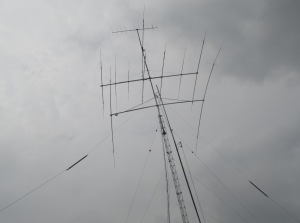 The HD2A station has previously been used twice by the SK6M Swedish Contest group signing HD2M. We have also enjoyed visits and operations from Hams Worldwide such
as from: JA, W, OA, LU, DL, UA, VE, I, EA and HK…and others that I cannot recall at this moment.
The HD2A station has previously been used twice by the SK6M Swedish Contest group signing HD2M. We have also enjoyed visits and operations from Hams Worldwide such
as from: JA, W, OA, LU, DL, UA, VE, I, EA and HK…and others that I cannot recall at this moment.We appreciate the efforts of others that have donated items such as tubes, relays, filters, and other items in order to maintain our multiple transceivers: TS-590, TS-2000, TS-430, TS-130, Yaesu FT-901MD and amplifiers: TL-922, DTR-3000, Drake L-7 and Heathkit SB-220 and 200. We also appreciate those that loan us their own personal equipment for use during contests.
For antenas we have multiple arrays: 5 element monoband Yagi’s for 10 and 20 meters, a 4 element monoband Yagi on 15 meters, a 2 element Yagi and an Inv-V on 40 meters, an inverted-L on 160 meters, a vertical for 80 meters.
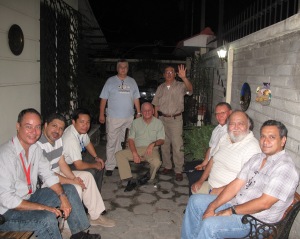 Some of the antennas have been modeled and designed by Alex, HC2AO. We also have Beverage receive antennas favoring JA, EU and the USA/VE.
Some of the antennas have been modeled and designed by Alex, HC2AO. We also have Beverage receive antennas favoring JA, EU and the USA/VE.We would also like to recognize others that have participated in one way or another in helping the HD2A contest station: Allan-HC2A, Victor-HC2DR, Tobi-DH1TW and Rick-NE8Z/HC1MD.
Part of my personal Code of Conduct comes from the Creed of the Junior Chamber International, “the brotherhood of man transcends the sovereignty of nations.” This motto comes alive in all of our DX contacts. More pictures: 1 2 3 4 5
Download PowerPoint presentation "VISTA AEREA DE GUAYAQUIL" (5.8Mb)
I now leave you with these final sincere words: HD2A from Ecuador, in “the heart of the world”, awaits your calls and your visit also!” 73, Alberto-HC2AQ close
KL2R: The Two Rivers Contest Club - N1TX
May 2014
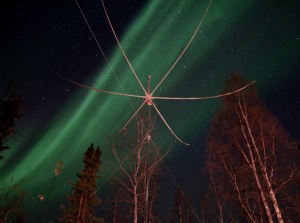 The Two Rivers Contest Club had very humble beginnings. The first seed was planted just over a decade ago. In late 2003, Rich Strand KL7RA was disassembling
his multi-multi station and had his spacious, split-level log home for sale. KL7RA had stood as a beacon for many years heating up the airwaves from about 20
miles east of Fairbanks. Rich was finally executing his post-retirement plan to move to Kenai, Alaska, where propagation promised to be far superior to the
ionospheric conditions under Fairbanks’ aurora. I had been a member of the KL7RA team for several years. Due to a change in family circumstances, my XYL Connie
KL1BE and I needed a place more suitable than our tiny cabin. Soon a deal was struck, and in April 2004 the five-acre property changed hands.
The Two Rivers Contest Club had very humble beginnings. The first seed was planted just over a decade ago. In late 2003, Rich Strand KL7RA was disassembling
his multi-multi station and had his spacious, split-level log home for sale. KL7RA had stood as a beacon for many years heating up the airwaves from about 20
miles east of Fairbanks. Rich was finally executing his post-retirement plan to move to Kenai, Alaska, where propagation promised to be far superior to the
ionospheric conditions under Fairbanks’ aurora. I had been a member of the KL7RA team for several years. Due to a change in family circumstances, my XYL Connie
KL1BE and I needed a place more suitable than our tiny cabin. Soon a deal was struck, and in April 2004 the five-acre property changed hands.More space for antennas and larger living quarters were both on my mind but a serious contest station was not part of the plan. As Rich and I were taking down the last 190-foot tower in June 2004, I proposed that he should sell me part of it. more
After a lot of sweat taking off the 40m beam and removing the top 50 feet, we reached an agreement and left 140 feet of the Rohn 55 and 45 still standing. Then I began to see the potential for a nice personal station, but I knew building out a decent HF operation would be a long-term process. I had some basic radio equipment and wire antennas but nothing else.
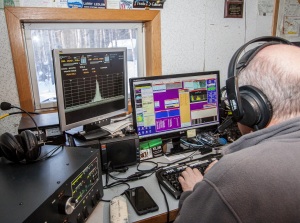 Over the next year I laid out some initial plans to populate the tower. I’m an engineer by trade, so I evaluated a lot of different antenna options. Rotators
are expensive, slow, and any breakage during the deep freeze of winter could be problematic. I settled on fixed antennas with a switch at the base of the tower.
From Fairbanks, reaching out to the rest of the world is pretty simple. North/South America are roughly east to southeast, Japan is west, Europe north, and the
Pacific is more or less due south. After evaluating tri-banders with a combination of modest gain and relatively low front-to-back ratio, I concluded I could
work the world with two fix-mounted antennas on the tower, which fit nicely into a modest budget.
Over the next year I laid out some initial plans to populate the tower. I’m an engineer by trade, so I evaluated a lot of different antenna options. Rotators
are expensive, slow, and any breakage during the deep freeze of winter could be problematic. I settled on fixed antennas with a switch at the base of the tower.
From Fairbanks, reaching out to the rest of the world is pretty simple. North/South America are roughly east to southeast, Japan is west, Europe north, and the
Pacific is more or less due south. After evaluating tri-banders with a combination of modest gain and relatively low front-to-back ratio, I concluded I could
work the world with two fix-mounted antennas on the tower, which fit nicely into a modest budget.One evening in 2006 during dinner with KL1JP, KL1SE, KL1Y, and N1CKM, we conceived of the Two Rivers Contest Club. Our objective became to build a station where members could come and explore different modes, try their hand at various contests, and overall just improve their own operating skills.
I set about applying for a club license. The original call granted was WL7CWF, and I soon changed it to KL2R, as in Two Rivers. Two Rivers, Alaska, is a rural community with a large dog-mushing demographic living side-by-side with eccentrics of all types, including several ham radio operators. It is roughly 20 miles east of Fairbanks on the way to Chena Hot Springs.
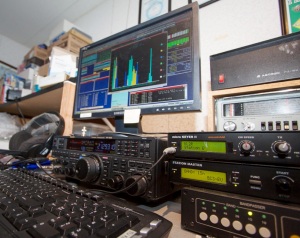 In 2006, CQWW proved to be some of the greatest challenges. In the SSB contest, KL1Y, KL1SE, and N1TX worked hard for contacts. KL1JP took ill but provided a
badly needed multiplier from his home QTH. The CW effort was SO1R by N1TX. 100 watts, one tri-bander, and the Super Loop 80 made for tough going but KL2R was
finally into the contest fray. The 2007 ARRL DX contests were fun and really two events for which KL2R was designed. Alaska is considered DX here.
We took Multi-Single in Alaska for both 2007 events without much cooperation on the low bands.
In 2006, CQWW proved to be some of the greatest challenges. In the SSB contest, KL1Y, KL1SE, and N1TX worked hard for contacts. KL1JP took ill but provided a
badly needed multiplier from his home QTH. The CW effort was SO1R by N1TX. 100 watts, one tri-bander, and the Super Loop 80 made for tough going but KL2R was
finally into the contest fray. The 2007 ARRL DX contests were fun and really two events for which KL2R was designed. Alaska is considered DX here.
We took Multi-Single in Alaska for both 2007 events without much cooperation on the low bands.Most of the original founders have since moved on. However, Dan Wietchy KL1JP and I remain principals and continue to improve the capabilities at KL2R. Today the tower sports two Force12 C3 tri-banders, one at 55 feet (North America/JA) and another at 75 feet (Europe/Pacific). We also have a Force12 EF-140 40m dipole at 120 feet optimized for east-west, a “vertical L” 80m dipole, and a Radio Works Super Loop 80 for 80-10, including WARC. These are tied together through a 6x2 matrix switch at the tower base (Array Solutions SixPak).
The Cushcraft MA-160V top band vertical feeds directly into the shack. Also, we have a rotatable HEX-BEAM erected on a short mast at the shack, but this will soon move to a new location in the woods. Ground mounts have been installed for 40 and 80 vertical arrays as well, and we hope to put up at least a 40m array in the summer of 2014.
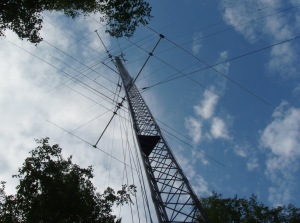 By late 2012, a solid multi-2 configuration was achieved with the addition of an Alpha 89 to complement the other amplifier, an
ACOM 1010. The shack features two
Yaesu FT-950s, Microham Microkeyer IIs, and
Microham Station Masters. The Station Masters handle band decoding as well
as antenna and accessory switching. Bandpass filtering is automated with a set of W3NQN filters connected through an Array Solutions FM-6 switch, and a
Hamation Bandpasser system takes care of the BPF needs at
the second position.
By late 2012, a solid multi-2 configuration was achieved with the addition of an Alpha 89 to complement the other amplifier, an
ACOM 1010. The shack features two
Yaesu FT-950s, Microham Microkeyer IIs, and
Microham Station Masters. The Station Masters handle band decoding as well
as antenna and accessory switching. Bandpass filtering is automated with a set of W3NQN filters connected through an Array Solutions FM-6 switch, and a
Hamation Bandpasser system takes care of the BPF needs at
the second position.We are always experimenting with different hardware configurations to boost operator efficiency as well as situational awareness. The original FT-950 included a DMU-2000 data management unit. As one might expect, the most-used feature on the DMU-2000 is the RF band scope. Most recently, the second FT-950 got a significant upgrade with an RF Space IF-2000 board, which provides 10.55 MHz IF output from the radio. To that we added an inexpensive FiFi software-defined radio.
The combination of the FiFi and HDSDR software now provides a very effective band scope with point-and-click tuning ability. Having a second in-band receiver is very handy, too. The FiFi can also drive skimmer software for CW and RTTY station identification. During non-contest times and availability permits, the FiFi remains on and sends HF spots to the Reverse Beacon Network. It is the only skimmer in Alaska to date.
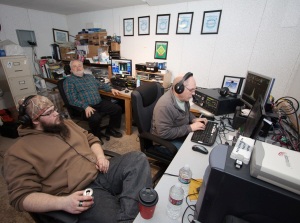 Along with N1TX and KL1JP, Carl Horn WL7BDO and Elaine Meindl KL6C make up the remaining core of multi-op teams. During ARRL DX SSB 2014, new ham Wes Worker
KL3UI distinguished himself alongside Bill Lippert AC0W, our long-distance guest op up from Minnesota. Elaine had to sit this one out for another obligation.
In the end, 3000 QSOs and nearly 1.5 million points landed in the log despite virtually no contacts on the low bands.
Along with N1TX and KL1JP, Carl Horn WL7BDO and Elaine Meindl KL6C make up the remaining core of multi-op teams. During ARRL DX SSB 2014, new ham Wes Worker
KL3UI distinguished himself alongside Bill Lippert AC0W, our long-distance guest op up from Minnesota. Elaine had to sit this one out for another obligation.
In the end, 3000 QSOs and nearly 1.5 million points landed in the log despite virtually no contacts on the low bands.The DX contest demonstrated some very key differences in propagation between our 65-degree north location and more southern sites like Anchorage and Kenai. Low-bands were quite active for them, and the other bands may open an hour earlier. HF propagation in the very high latitudes is fickle. Fairbanks sits under an active auroral zone. At times, it’s like being inside a box. We might work an OH or UA0, whereas reaching to W7 is nearly impossible. The geomagnetic field and ionosphere are tilted dramatically near the poles.
The conventional wisdom about HF propagation repeated in countless books and learned at lower latitudes simply does not apply. Paths are frequently non-reciprocal and skewed. A Kp of three or greater will manifest like a door flopping open in the wind as the geomagnetic field alternatively twists, expands, and compresses. Absorption on the southbound link is much greater. Digital contacts like JT65-A show the station receiving our call will send a 8 to 16 dB worse signal report compared to our report to him.
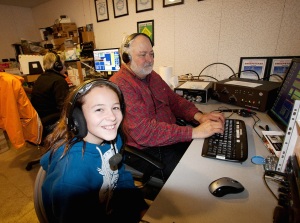 A number of years using 100 watts in these conditions have helped hone operating techniques. Search and pounce was essential in those days, finding key
multipliers is high on our priority list. Now we can easily generate good run rates on 20-10.
A number of years using 100 watts in these conditions have helped hone operating techniques. Search and pounce was essential in those days, finding key
multipliers is high on our priority list. Now we can easily generate good run rates on 20-10.Occasionally, 40m cooperates with some good worldwide openings. Gray line enhancement is almost a given, but the duration varies from 30 minutes to a couple of hours. The MA-160V has yielded some surprising top band contacts, but the band now suffers from S9+10 dB power line noise after a series of recent winter storms. Eighty meters is almost always a light band. We can work into W6 and W7, but anything beyond is difficult. In short, the low bands are our weakest link. On the other hand, if the sun blesses us then 10m can be open 24 hours a day worldwide. Those European three point contacts and multipliers give us a leg up. A contest station generates some pretty big logs. Effective management and comprehensive QSL functions are essential.
I spent quite a while looking at alternatives for software. I went through many trial copies of commercial products as well as freebies. It turned into a playoff between Ham Radio Deluxe and DXLab Suite, and I finally settled on the latter. DXKeeper, the logbook module, has some very powerful features using simple SQL queries. DXSuite has a number of other useful modules for more casual operating. It can also integrate into many other programs.
 KL2R participates in LoTW, eQSL and Clublog. Hams can use the online QSL request system at Clublog or from our web site at
www.akradio.net All bureau cards (free) go via GlobalQSL. Processing contest logs for LoTW and eQSL
may take a week. Clublog is updated about once a month, depending on activity. We have a strict policy about QSLing to personal calls when you worked us
from a special event or club station. Unless your callsign is in the log, no QSL. Early on we were inundated with such requests, most people seem to have
gotten the message now.
KL2R participates in LoTW, eQSL and Clublog. Hams can use the online QSL request system at Clublog or from our web site at
www.akradio.net All bureau cards (free) go via GlobalQSL. Processing contest logs for LoTW and eQSL
may take a week. Clublog is updated about once a month, depending on activity. We have a strict policy about QSLing to personal calls when you worked us
from a special event or club station. Unless your callsign is in the log, no QSL. Early on we were inundated with such requests, most people seem to have
gotten the message now.The ten year journey to this point with KL2R has been an interesting trek for many people. At times, it has proven to be a “you’d better be careful what you wish for” project. Antenna improvements are always on the drawing board. Much of the technology has been mastered to date, but developing a local cadre for CW and RTTY contests will be a high priority. Future operating plans include the W1AW/KL7 activity in June and October 2014. More pictures: 1 2 3 close
CR3L: an RRDXA Amateur Radio Station on Madeira - Uli Weiß DJ2YA
May 2014
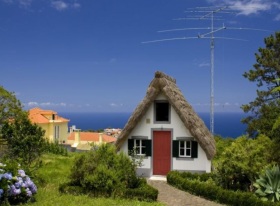 On the wonderful island of Madeira, 400 miles off the north-west African coast, the Rhein-Ruhr-Association (RRDXA) runs a contest site for their teams to
contribute to the club scores in major contests.
On the wonderful island of Madeira, 400 miles off the north-west African coast, the Rhein-Ruhr-Association (RRDXA) runs a contest site for their teams to
contribute to the club scores in major contests.It is situated on the site of a hiking hostel with an area of about 3 acres that offers accommodation for up to 16 people in its eight rooms each with its own private bathroom. A well equipped kitchen allows self catering and there is a spacious lounge with comfortable furniture and a big fireplace for a cosy atmosphere.
The shack is housed in a typical thatched Santana hut close to the main building with its loft serving as storage room for spare materials, such as poles and antennas that can be erected additionally to the permanently mounted beams for 7, 14, 18, 21, 24, 28 and 50 MHz on two 40 foot and 60 foot crank up towers. more
 There is plenty of space for low-band verticals (on 18m-Spider-Poles) to be temporarily erected for a contest weekend as well as loops or Beverages for NA
(100m) and EU (150m), the main directions in contests.
There is plenty of space for low-band verticals (on 18m-Spider-Poles) to be temporarily erected for a contest weekend as well as loops or Beverages for NA
(100m) and EU (150m), the main directions in contests.For M/2 or M/M the teams usually have a full double set of beams from 40m to 10m for NA and EU (+JA) at their disposal.
The standard 230V mains, fully sufficient for single-operation, can be supplemented by temporary 3 phase 400V power lines to feed several linear amplifiers for multitransmitter operation.
Fast and reliable Internet access is provided by a temporary line to a router in the main building and the 5 computers in the shack are linked in a dedicated Ethernet LAN.
 Most operators bring their own K3s additionally to the TS590 and FT990 that stay permanently on the island together with several home brew one kw amplifiers.
Most operators bring their own K3s additionally to the TS590 and FT990 that stay permanently on the island together with several home brew one kw amplifiers.From a height of about 400m ASL the antennas look down on the Atlantic Ocean when beaming to Europe. The shot to NA is not quite that good with a horizon of around 2 degrees at a distance of about 5 miles over land.
Nevertheless, CR3L (akas CQ3L) is surely one of the assets of the RRDXA with a yearly average of almost 50 million points towards the CQWW Club Score during the last 5 years with more than 20 world high scores and two current world records in CQWW, ARRL-DX, and WAEDC Contests. For further details (and pictures) you may check the web site at www.cr3l.de
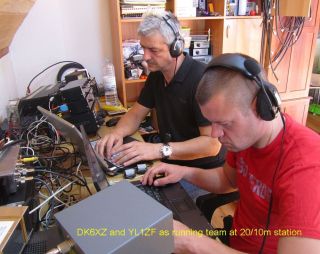 Politically and economically the island of Madeira belongs to Europe as an autonomous region of Portugal. However, radio-wise it belongs to the African continent
with the great advantage that almost all contest contacts count 3 points.
Politically and economically the island of Madeira belongs to Europe as an autonomous region of Portugal. However, radio-wise it belongs to the African continent
with the great advantage that almost all contest contacts count 3 points.As the island is a popular holiday resort there are daily non-stop flights there from most German international airports. Alternatively you can go via Lisbon by the Portuguese TAP. Our teams usually fly on Tuesdays to rig up the station until Friday for the contest at the weekend. On Monday all extra antennas must be dismantled and carefully packed up to be stored for the next operation before flying home on Tuesday.
International guest operators for all modes are most welcome. If you are interested to join one of our teams, write an e-mail to Walter (dj6qt@t-online.de) who is in charge of the organisation.
CU at CR3L or CQ3L and vy 73 de Uli, DJ2YA.less
The DL1A Contest Station - Maik Reckeweg DJ2QV
April 2014
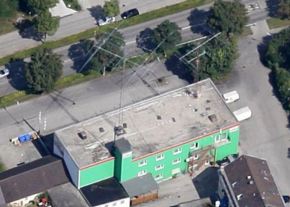 DL1A is a privately owned station located about 15km west of Munich. The station owner is Tof DJ6ZM who is operating from this location since the late 60s.
All towers and antennas are located on the roof of his furniture store, a two storey building measuring approximately 40m x 15m. The station is used for Contests
as well as for individual remote operation via Internet.
DL1A is a privately owned station located about 15km west of Munich. The station owner is Tof DJ6ZM who is operating from this location since the late 60s.
All towers and antennas are located on the roof of his furniture store, a two storey building measuring approximately 40m x 15m. The station is used for Contests
as well as for individual remote operation via Internet.The QTH is located in the city center of Germering a suburban town of Munich with approx. 38.000 inhabitants. Train station, restaurants and hotels are within walking distance which is nice, but obviously the location suffers from man-made noise - particularly on the low bands.
Serious Contest operations started around 2008 when several active contest operators moved to Munich and joined the activities at DL1A. more
Currently the core team consists of DJ6ZM DJ1YFK DJ2QV DK7AH and DO4DXA. But there are many other operators and helpers, such as DD1LD DF9TS DH7KU DJ3WE DJ0ZY DK4AA DL3OBQ DL9NEI DK8MZ DK9CG and DL1MDZ. Also guest operators like DJ5MW DL2OBF W4PA S56A HB9CVQ or KJ5T have been active from the station.
All antennas are installed on 3 towers on the roof (approx. 10m high) due to the limited roof space. Tower 1 is a 31m full rotating tower which is equipped only with Monoband Yagis. Tower 2 is 17m high and equipped with an Optibeam 17-4 and a 2 ele Yagi for 30m. Tower 3 is 10m high and holds an Optibeam OB9-5. 160m TX is a wire inverted L between the towers and an active RX Loop.
In total 10 Antenna cables enter the shack and they can be switched to any of the 5 Radios by means of a Microham Switch Matrix. All monoband antennas are equipped with 4O3A high power bandpass filters. This allows remote operation of up to 5 people simultaneously on 5 different bands. A homemade bandlocking device ensures that two stations can never operate on the same band in order to avoid receiver damage.
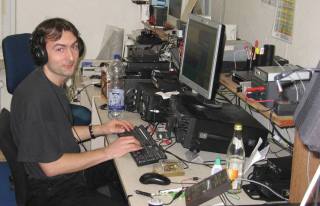 During Contests we usually combine the antennas of two stations with a Microham Stackmax, so we can cover two directions simultaneously from two Running stations.
A third station remains available as backup or as an interlocked Multiplier search station.
During Contests we usually combine the antennas of two stations with a Microham Stackmax, so we can cover two directions simultaneously from two Running stations.
A third station remains available as backup or as an interlocked Multiplier search station.We use different types of radios. For remote operation three stations are equipped with TS-480s and remote rig Interfaces. These can be switched over to FT-2000 during contest operation. A FT-DX 5000 and a K3 are also used via remote and during contests. The two main amplifiers are ACOM 2000As and the other stations are equipped with Expert 1K or 2K.
The shack features two operating rooms, a "meeting room", shower and a large storage and bedroom.
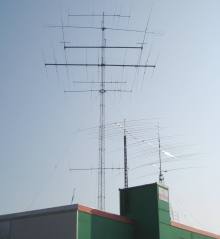 We usually operate the major CW and mixed mode Contests like ARRL-DX, Russian DX, WPX, WAE, WAG and CQWW-DX in the M/2 or M/S class as DL1A or DM9K (in WPX).
Occasional M/M operations have taken place (DA0HST) but the station is not really capable for M/M. In 2012 and 2013 we have operated the german headquarter
station DA0HQ on 40m CW.
We usually operate the major CW and mixed mode Contests like ARRL-DX, Russian DX, WPX, WAE, WAG and CQWW-DX in the M/2 or M/S class as DL1A or DM9K (in WPX).
Occasional M/M operations have taken place (DA0HST) but the station is not really capable for M/M. In 2012 and 2013 we have operated the german headquarter
station DA0HQ on 40m CW.Lately we have also been using a second inband station to S&P in parallel on at least one RUN band, however we have no RX Antennas far away enough to allow us to listen while we are transmitting, so this operating mode only gives us a small but still useful advantage.
Unfortunately the future of DL1A is currently uncertain. Very likely the furniture store will move to a different building very soon and we have to take down all masts and antennas probably this summer. Currently we are searching for a new location in order to keep the down-time as short as possible. Keep your fingers crossed for us.
More pictures: 1 2 3 Maik DJ2QV for the DL1A Team close






